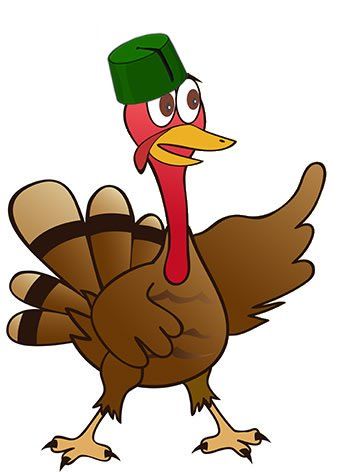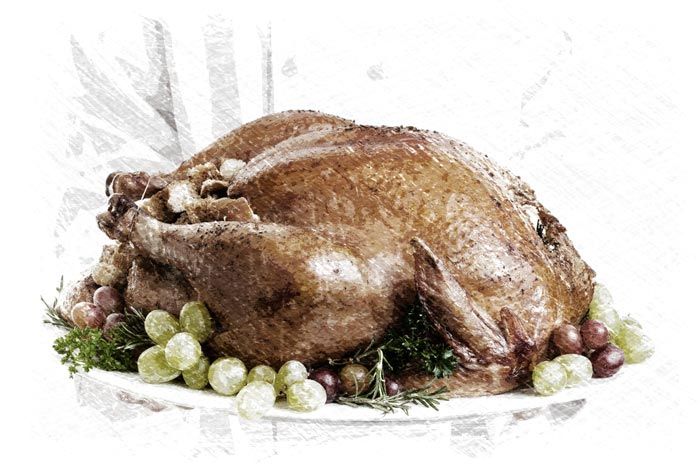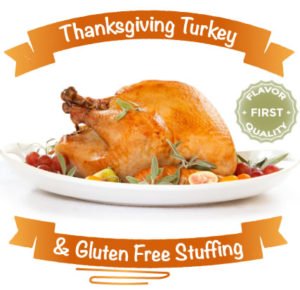The Turkey & Gluten-Free Stuffing
It is time to talk turkey ... specifically that celebration dish of the perfectly cooked turkey that Autumn brings to festive tables all across North America.
The turkey has a lot of folklore attached to it that make it a fun conversational food as well as a season treat with few equals. Many people have heard that Benjamin Franklin wanted the Turkey instead of the Bald Eagle as the symbol for the United States … well, this myth was thoroughly tossed out by the excellent article by the Smithsonian article in early 2013. It makes for fun discussion but according to my many friends in the U.S., the eagle is much better while suggesting that the turkey is better suited as the bird to represent the U.S. Congress (humor there).
Why a turkey is called a “Turkey”?
The turkey is new to the earth as a species (11 million years ago) and native to North America which is the reason turkey dinners in Europe or Asia pre-1500 in history never could happen. It always makes me laugh when on a television program some 1200’s Medieval feast has a huge turkey on the table … not possible.
The turkey had a tough time of it during ice ages and once you add humans to the predator chain, quite a few species of turkey became extinct, some relatively recently. The turkey indigenous to California (Meleagris californica) only 10,000 years ago.
Turkeys have their own family and for a long time were considered pretty unique, however in this world of genomic analysis the turkey is now recognized as belonging to that broad group of pheasants, partridges, chickens, quail, etc that is known as Pasianidae.

Ever wonder why on Earth we call this wonderful bird after a Middle Eastern country? This is fun. The first Europeans documented to eat turkey were Spanish, specifically the soldiers in Hernan Cortez’s expedition to the New World in 1519, today Mexico. By 1524 turkeys were exported to England and were a hit. Within a decade they were being raised actively.
The ships selling these birds were based out of Constantinople (today Istanbul) in Turkey and anything these guys sold was generically called “turkey this” and “turkey that”. Persian carpets were called Turkish rugs for example. Cigarettes were called Turkish cigarettes. The bird was called a “turkey cock” later shortened to Turkey.
This name entered the English language and was widely accepted, actually appearing in a Shakespeare play Twelfth Night in 1602.
So that is why a turkey is called a “Turkey” and before we give too much credit to the Spanish, English, and French settlers eating turkey in North America, let us keep in mind that Vikings were the first known Europeans to come to North America. It is more than likely Vikings were actually the first Europeans to feast on Turkeys 🙂
The Thanksgiving Feast comes from the early settlers to the Americas from England but let’s all keep in mind that Autumn harvest feasts are a pretty basic tradition since forever because it was a time of Agricultural plenty.
Cooking turkey is a subject worthy of a whole book. There are HUNDREDS of wild & wolly ways to cook a turkey, all with fans screaming that they are the best.
The weirdest methods IMHO are: the Brown paper bag (!!) method, the Trash Bag (??) method, and the culinary-expertise-needed Turducken method (where you layer turkey, duck, and chicken with layers of stuffing between the layers … wow). Needless to say all of these methods are considered unsafe unless you modify the recipe a little as recommended by the links to the University of Illinois.
Brining the turkey:
So instead of looking at the esoteric and weird ways to cook turkey, let’s stick to the oven and the bird. “Brining the turkey” is simply a cool seasoning technique designed to produce a juicier bird with much moister light and dark meat after cooking.
“Wet-Brining” places the whole bird in a salt water solution for a day or two prior to cooking it while Dry-Brining is a dry rub kind of method. Although this works, salting and plunking the bird into a pot takes a lot of space in any fridge and I have always regretted the inability to get subtle herb flavours that I personally like in a seasoned turkey. If you want to go the wet brine route, here is an excellent recipe that works from the legendary Martha Stewart (I would increase the fennel).
I prefer dry brining.
Dry-Brining: More accurately called pre-seasoning, you rub salt, seasonings, etc directly on to the skin of the turkey, between the skin and the meat, & in the turkey cavity. That done, place into refrigeration, where the salt will draw out juices from the turkey. These juices pick up the seasoning, etc, and are reabsorbed by the turkey when cooking.
Everyone and their grandmother (literally in this case) has “the best” dry-brine seasoning recipe. Over the years I have begged and borrowed recipes from a lot of Chefs for this but it all comes down to the quality of the ingredients.
A good recipe with quality ingredients becomes great. Since most dry-brine seasoning recipes include herbs and spices … it is a good idea to not go cheap here.
My dry-brine seasoning for a 8 Kg turkey:
6 tablespoons of good quality natural sea salt.
1 teaspoon Rosemary dried or fresh chopped very fine. (recommend AOC).
- 1 teaspoon of dried thyme ground fine (recommend AOC).
- 1.5 tablespoons of freshly & finely ground tellicherry black pepper.
- 1 heaping tablespoon of naturally brown sugar finely ground.
I make more than you would think because I want to make sure it is everywhere. After you pat the turkey dry removing neck + giblets from the cavity, loosen the skin around the breasts, legs, and sides of the turkey making sure to get to the meat beyond the thin membrane between the meat and the skin. 4 tablespoons of seasoning rubbed around the inside of the turkey. 4 tablespoons of seasoning rubbed under the skin. Take your time. This part of preparation is very Zen so smile (before you reach for your glass of wine). Now season the skin well with the remainder. Into the fridge covered for two days (3 days if you can). Ready to cook!
Stuffing the turkey:
Next step is the Stuffing. You can write a second book just on stuffing so let’s consider the philosophy of stuffing:
Excellent ingredients.
Should not suck moisture from the turkey.
- Should not duplicate the seasonings in the dry brine step, so no salt and pepper as there is plenty in the cavity of the turkey already 😉
- Should be able to accompany the meat.
I grew up with turkey stuffing so extraordinary that extra was made every time, on the side, for decades.

Many families have “their secret, best recipe” and I respect that. This is mine, a three generation treatment very French-oriented which has been made with the ingredients Qualifirst has imported since 1957. This Gluten-free stuffing recipe is from Mrs. Nicole Farges (80+ years).







